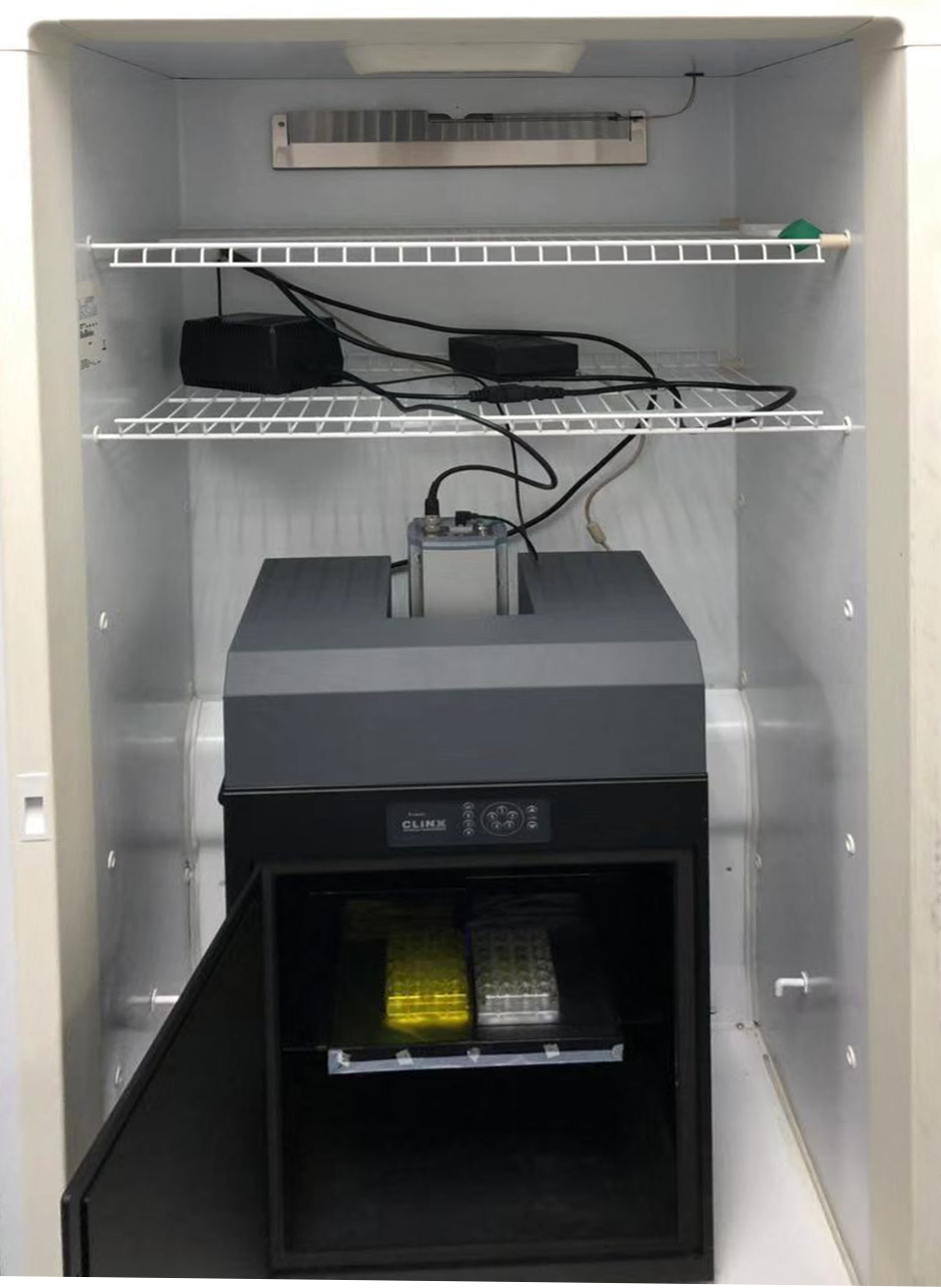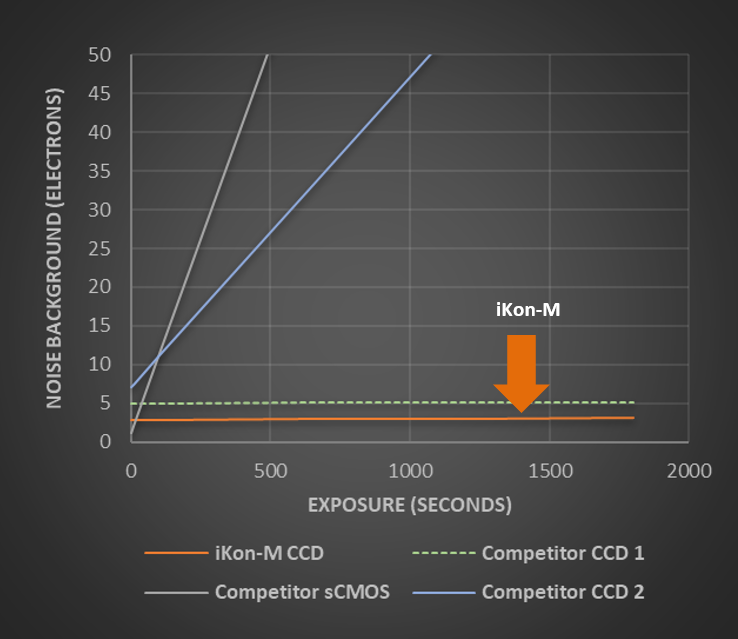Genetic reporting systems based on luminescence are exceptionally sensitive, being widely employed in the study of gene expression in bacteria, plants and the in vivo study of small animals. Systems utilizing luciferase are able to facilitate accurate quantification of minute changes in transcription within complex biological systems.
These signals involved are very weak, in contrast to those found in fluorescence. The background is inherently low, however. While autofluorescence is prone to interfering with and masking signal information, this does not occur when using fluorescence.
The perturbation of normal cell processes commonly caused by illumination is also avoided. Luminescence offers the ability to reveal transcriptional regulation in more detail than has been possible using traditional methods.
The iKon-M deep-cooled CCD camera is a commonly used tool in luminescence imaging. Example setups may use a temperature-controlled light sealed chamber for plant imaging, high throughput plate formats or microfluidic systems.

The iKon-M deep cooled CCD camera is widely used for luminescence imaging. In this example within a temperature-controlled light sealed chamber for plant imaging. Many other set-ups using high throughput plate format or microfluidic systems are also in use. Image Credit: Andor Technology Ltd.
Bioluminescence studies offer a range of benefits, but these do pose a range of detection challenges. These detection challenges differ from those common with typical fluorescence microscopy-based imaging. Some of these challenges are outlined below.
Sensitivity
Luminescence reactions will only generate a limited number of photons. It is, therefore, essential that the detector in use offers maximum sensitivity in order to capture the emitted photons over time. This will allow the detector to generate a useful signal.
Ultra-low Noise
The signal will be weak, so it is important that background noise is maintained at as low a level as possible. Exposures of 10 minutes or longer ensure that measurements are ‘dark current’ limited.
The detector must therefore offer the lowest possible dark current – minimalizing any self-generated thermal noise that may accumulate within the camera sensor.
Quantitative Accuracy
Shifts in promotor analysis, expression, or cell signaling pathways have the potential to exhibit subtle yet important differences. A good detector should be able to distinguish between these differences in order to better elucidate experimental data.
Dynamic Range
Capturing low and high level information within the same image requires the availability of a wide dynamic range.
Technology Solution
Deep-cooled CCD cameras offer an ideal solution for luminescence experiments, with CCD cameras offering lower dark current than rapid sCMOS cameras by as much as 1000-> fold. Deep-cooling the CCD to all but eliminate dark current is essential for these long exposures, which often extend to many minutes in length.
CCD cameras include sensor options with high quantum efficiency, facilitating a wide enough response for a range of luminescence reporter systems. Specific models also offer a wide dynamic range and the high linearity necessary for quantitative measurements.
The iKon-M deep cooled CCD camera provides the lowest background noise due to a combination of the lowest possible dark current and low read noise. High sensitivity is ensured thanks to the instrument’s ultra-low background combined with a high quantum efficiency (QE) of >90%.
The iKon-M CCD’s performance becomes especially apparent when working with longer exposures.

The iKon-M deep cooled CCD camera delivers the lowest background noise due to the combination of low read noise and the lowest possible dark current. This ultra-low background combines with high QE of >90% for the best possible sensitivity. The performance of the iKon-M CCD is especially apparent with longer exposures. Image Credit: Andor Technology Ltd.
The iKon Series: Andor Camera Solution for Plant Luminescence Imaging
The most challenging luminescence experiments are made simple by Andor’s iKon CCD camera series - the most sensitive CCD cameras currently available.
The exclusive UltraVac™ permanent vacuum technology and stable, efficient thermoelectric cooling to -100°C are central to the cameras’ industry-leading performance.
iKon CCD cameras can drive dark current down to the lowest levels possible, with a QE of up to 95% ensuring the highest sensitivity. A c-mount fitting allows the iKon-M CCD model to be coupled to a microscope or to a lens when used as part of a custom optical setup.
Requirements and Benefits of iKon-M for Luminescence
The iKon-M CCD camera offers a range of benefits when used with luminescence experiments.
Detect Very Weak Photon Emission Signals from Luciferase Activity
The iKon-M CCD camera captures every photon possible, thanks to its >90% QE across the emission wavelength range of the majority of luciferases.
A 13 µm pixel size ensures a balance of photon collection and high resolution, with a 1024x1024 sensor format ensuring combability with the industry-standard c-mount lens format. This results in enhanced photon detection along with accelerated experimental throughput.
Extended Time Measurements With Exposures of Minutes
Industry-leading cooling as low as -100°C allows the iKon-M to provide the lowest possible dark current.
The best possible signal to noise ratio and lowest possible noise floor can be achieved, even when working with long exposures of 20-30 minutes. Effective separation of the signal is ensured against the lowest possible background.
Record Accurate Physiology
Excellent sensitivity is combined with exceptional quantitative accuracy, meaning it is possible to discover subtle effects at the transcription level, for example, variations due to circadian rhythms. This allows users to maintain utmost confidence in their data.
Quantify Weak and High Level Signals in a Single Image
A wide dynamic range is ensured thanks to a signal handling capacity of up to 130000 e. High level signals and low level information can be quantified simultaneously, providing tangible benefits in experimental design and allowing wide signal levels within a single experiment
Users are therefore able to acquire accurate physiological data in one image.
Quality and Longevity
The iKon-L is supplied with a 5-year guarantee on the UltraVac™ vacuum sensor enclosure. The permanent vacuum process is well proven, and this is critical for both cooling and protection of the back-illuminated sensor against condensates and moisture. These factors combine to ensure sustained high performance.
Imaging Single Cell Bioluminescence
Even higher sensitivity may be necessary when moving from typical luminescence experiments towards studies at the single cell level. The iXon EMCCD series is ideal for these studies.
References
- Fei Wang, Yongshun Gao, Yawen Liu, Xin Zhang, Xingxing Gu, Dingbang Ma, Zhiwei Zhao, Zhenjiang Yuan, Hongwei Xue, Hongtao Liu. BES1 regulated BEE1 controls photoperiodic flowering downstream of blue light signaling pathway in Arabidopsis. 2019 New Phytologist.
- Yeon Jeong Kim, David E Somers. Luciferase-Based Screen for Post-translational Control Factors in the Regulation of the Pseudo-Response Regulator PRR7. Frontiers in Plant Science. 2019 VOLUME 10. https://www.frontiersin.org/article/10.3389/fpls.2019.00667. DOI=10.3389/fpls.2019.00667
- Kui Han, Long Mei, Ruoyu Zhong, Yuhong Pang, Eric Erquan Zhang and Yanyi Huang (2020) A microfluidic approach for experimentally modelling the intercellular coupling system of a mammalian circadian clock at single-cell level. Lab Chip, 2020,20, 1204-1211 https://doi.org/10.1039/D0LC00140F
- Battle, MW and Jones, MA. Cryptochromes integrate green light signals into the circadian system. Plant Cell Environ. 2020; 43: 16– 27. https://doi.org/10.1111/pce.13643

This information has been sourced, reviewed and adapted from materials provided by Andor Technology Ltd.
For more information on this source, please visit Andor Technology Ltd.